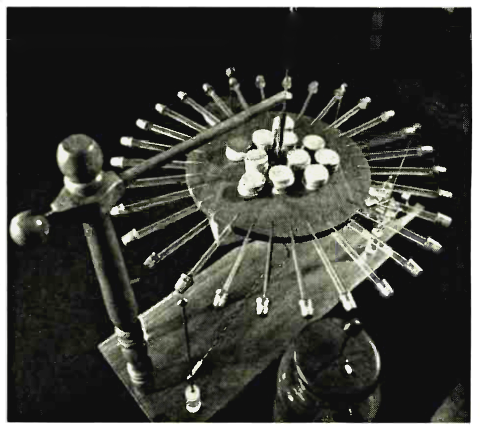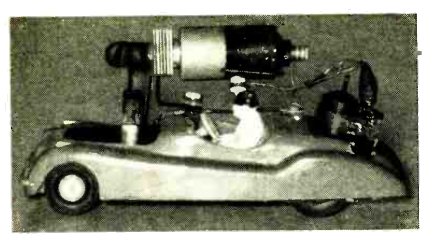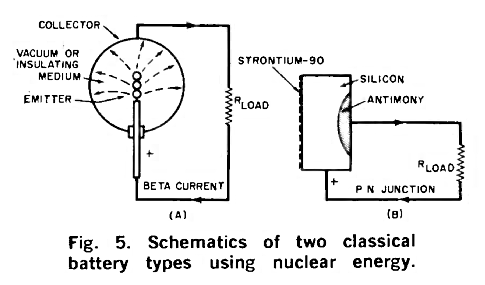Electric Power from the Earth
The Search for Natural Sources of Energy Goes On
By L. George Lawrence
MOST economists agree that present of living can be maintained only if more electrical power is made available every year. Unfortunately, to obtain power from traditional sources means pollution; getting more power from these sources means more pollution. Consequently, it comes as no surprise that a great deal of effort and capital are being invested in attempts to find "cleaner" sources of electricity than we have been using. Along these lines, we find renewed interest not only in geoelectric phenomena, but also in exotic energy-conversion schemes with excellent promise for the not-too-distant future. So far, everything has been very experimental, but, at last, a beginning has been made.
To geophysicists and electrical engineers, our planet is a powerful generator of do power in the trillion-kilowatt (1012) range. Its dynamo action is due partially to axial rotation and the magnetic interaction in ionospheric fields and partially to thermo-couple-type phenomena between the hot magma of the earth's core and the cold crust. The natural earth, or telluric, currents flow in large "sheets." While apparently weak, telluric currents can attain immense magnitudes in submarine telephone cables when certain geoelectric conditions coincide. (Submarine cables between the U.S. and Europe frequently produced terminal voltages up to 2500 volts.)
The question is, how can we harness this power? Studies are currently under way to determine how to increase the current flow in ore-bearing bodies and store the electrical energy potentials in buffers or accumulators for later use. Special provisions must be made for possible telluric polarity changes to safeguard dc-to-ac converter systems. Another force that is available for immediate use is that of electrostatic energy. Electric fields, currents, and conductivity, as well as positive and negative ions of greatly varying size, constitute the principal electrical properties of the atmosphere in fair weather. In the altitude between 30 and 70 kilometers, atmospheric studies of electricity and ionospheric physics merge. Remarkably enough, Benjamin Franklin was among the very first people to envision the enormous potential of static electricity in industry. An exact replica of his electro-static corona motor, recreated at West Virginia University by Dr. Oleg Jefimneko and David K. Walker, is shown in Fig. 1. The propulsive force for the motor disk is obtained from discharge electrodes placed at strategic points around the disk's circumference. A Leyden jar (lower right in photo) serves as the high-voltage storage/discharge component.
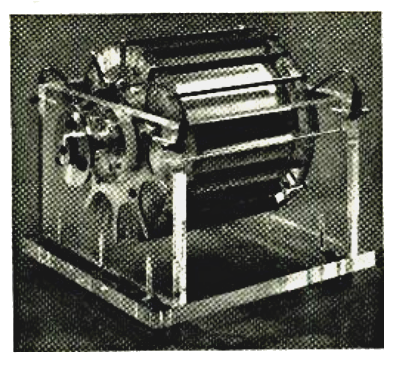
Fig. 2. The electrostatic motor shown here can develop 1/10 horsepower by using an antenna carried by a balloon.
The latest version of the WVU electro-static motor is shown in Fig. 2. Like similar machines, the insulated knife-edge electrodes generate a corona that charges or ionizes air particles floating by. The latter transfer their charge to the nearest part of the plastic rotor and charge it. Now, once a spot on the rotor takes a charge, it will be repelled by simple electrostatic force from the charging electrode. A simultaneous attraction toward the other, oppositely-charged, electrode takes place. So, when the charged portion of the rotor reaches the opposite electrode, another corona discharge takes place, reversing the polarity, and the cycle repeats itself.
The Jefimenko model shown can develop 0.10 horsepower if energized by a 30,000-volt electrostatic generator. Operation by natural electrostatic electricity requires that the feeder antenna be carried aloft by kite or balloon to a height of 200 to 300 ft above ground to obtain an operating potential of about 20,000 volts. Of course, all of this sounds promising, hut our society is in a hurry and needs large amounts of power now.
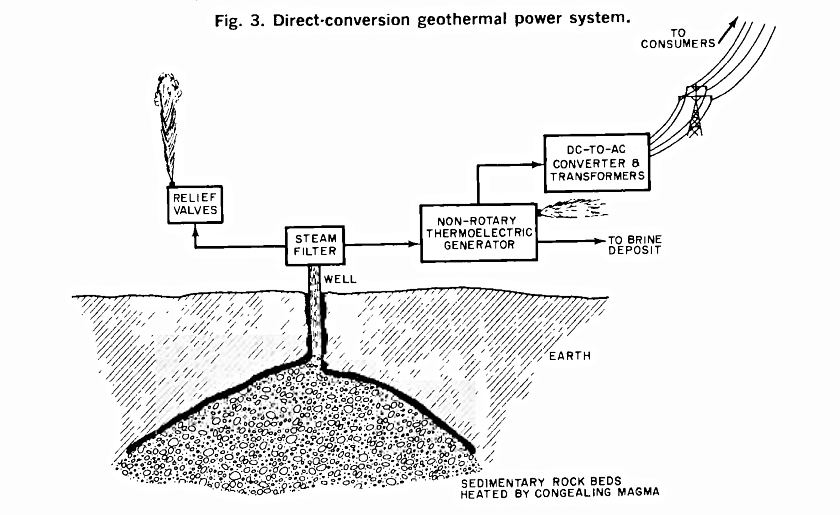
More Practical Approaches. Presently, considerable attention and a great deal of money are being used to exploit hot springs and natural geysers as sources of power. One promising spring is at Cerro Prieto in northern Mexico, where Toshiba of Japan has installed specially designed turbines to convert escaping steam into electrical power. But the turbine generator conversion process is not ideal; so more direct heat-to-electricity conversion processes are being developed.
Typically, a geothermal spring is made up of a vast underground deposit of spongy sedimentary rock (see Fig. 3) that traps water that has been heated to the boiling point by heat conduction from the solid rock below. The heat is furnished by congealing magma pushed up from the earth's molten core. Geologists have estimated that, in the case of the Mexican and Salton Sea trough systems, spongy rocks to a depth of 20,000 ft exist, giving an immense energy reservoir. However, in the system concept shown, it is desirable that turbines and the like are avoided altogether either by tapping the heat directly (to avoid turbine contaminations) or by feeding the hot steam into a non-rotary thermoelectric generator as shown. Once fully developed, direct heat-to-electricity converters are cheaper than turbine generators and offer fewer logistical problems in the long run.
Right now, although good progress is being made, problems reside in the area of efficient conversion cells. This field is wide open for new inventions in light of the fact that the need is one of here and now. A small experimental car, about 8-in. long and containing a small electric motor, is driven by an electronics-based thermo-tunnel converter invented and patented by F.N. Huffman (Fig. 4). The converter uses 10-40 angstrom-thick oxide spacers between the emitter and collector of the heat-to-electricity conversion assembly. Buffer resistors are inserted in the device to insure an even load balance from all current-generating cells during parallel operation.
While at first glance, Huffman's invention (little more than a sophisticated thermocouple) seems insignificant, it bears great promise for large-scale power plants. What remains is essentially an engineering job of finding a packaging scheme that will permit this type of cell to be directly heated by the earth's magma or steam from hot springs.
Work is also under way in the field of atomic power plants. The specific aim is to bypass the traditional nuclear power plant and its cumbersome reactors, turbines, and the like by realizing the current-generating capacity of the radioactive materials themselves. In Fig. 5 are shown two "classical" nuclear battery types. The design in (A) is a beta-current type in which high-speed electrons emerge from the radioisotope coated on a central emitter electrode and are collected by an outer conducting member. Design (B), coated on one side with Strontium-90, allows the radiation to produce an electron avalanche in one element of the junction diode. These electrons are collected by the "field" across the junction. The field is established by a physical process similar to the collecting field in the contact-potential-difference cell.
Unfortunately, these two and similar types of batteries produce very low output powers, typically in the micro-watt range. However, cell (B) continues to be promising because its electromotive force is about 0.2 volt per cell. So, if a large number of radiation-proofed cells can be connected in series - parallel combinations, adequate power outputs might be realized. Current cell failures are due to changes in the crystalline structure of the silicon that are the result of radiation from the radioactive material. But it is this type of solid-state battery that holds the great promise for electric-powered cars, homes, and industrial undertakings.
Originally published in "Popular Electronics" (April 1973). Browse AmericanRadioHistory.com for complete issues of P.E. and many other historical radio and electrical publications in PDF format.
Return to the BIO-ICOMM Project homepage or the Bibliography of L. George Lawrence.

